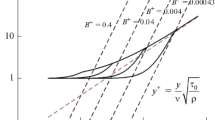Abstract
It is shown that a turbulent flow can support elastic waves for which the fluctuating stress is essentially proportional to the strain field. These fluctuations are described by a hyperbolic system and hence they do not decay away from a solid boundary. Their behaviour is also consistent with Taylor's “frozen field” hypothesis that turbulent fluctuations are advected with the local mean flow speed.
Similar content being viewed by others
References
Crow, S. C., J. Fluid Mech. 33 (1968) 1.
Rotta, J., Z. Physik 129 (1951) 547.
Manton, M. J., Boundary-Layer Metorol. 2 (1972) 348.
Lin, C. C., The Theory of Hydrodynamic Stability, Cambridge University Press 1955.
Whitham, G. B., J. Fluid Mech. 9 (1960) 347.
Cole, J. D., Perturbation Methods in Applied Mathematics, Blaisdell 1968.
Abramowitz, M. and I. A., Stegun, Handbook of Mathematical Functions, Dover 1965.
Author information
Authors and Affiliations
Rights and permissions
About this article
Cite this article
Manton, M.J. Elastic waves in a turbulent fluid. Appl. Sci. Res. 27, 219–233 (1973). https://doi.org/10.1007/BF00382487
Received:
Issue Date:
DOI: https://doi.org/10.1007/BF00382487




